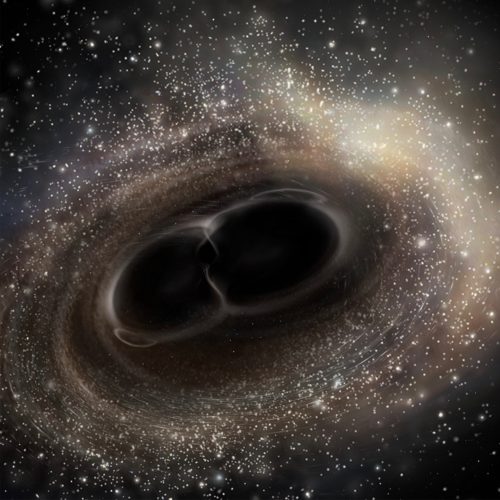Artist’s illustration of the merging binary black hole GW150914. Image credit: LIGO/A. Simonnet.
Binary black holes are excellent laboratories for testing predictions of Einstein’s theory of gravity, General Relativity. I am involved in multiple approaches to testing general relativity using gravitational-wave observations.
Black hole spectroscopy & the no-hair theorem
When two black holes merge, they form a new, larger black hole that is initially perturbed. The perturbation is quickly radiated away in gravitational waves. This post-merger waveform consists of a superposition of quasi-normal modes. Due to the no-hair theorem — which states that all black holes are entirely characterized by their mass, spin, and charge — we expect the frequency and damping time of all of the modes to be determined by the final black hole’s mass and spin (astrophysical black holes are expected to have zero charge). If a signal’s individual modes yield inconsistent masses and spins, it would indicate that more parameters are needed to characterize the final object, a violation of the no-hair theorem.
Testing the no-hair theorem is challenging. The post merger waveform damps away quickly [in ~a few milliseconds], and so the signal-to-noise ratio is low. The amplitudes of the sub-dominant quasi-normal modes — whose detection is necessary for a no-hair theorem test — have amplitudes that are (at best)
~30% of the dominant mode. Colleagues and I have shown that, in the coming decade, we might be able to constrain deviations from GR to < 20% with LIGO Voyager. LIGO Voyager is an upgrade to the LIGO detectors that is planned to start operation around 2030. Better constraints may be obtained more quickly by combining results over multiple events. We are currently studying this possibility.
Black-hole thermodynamics
The laws of black-hole mechanics were worked out in the 1970s by Bardeen, Carter, and Hawking. When two black holes merge, the area of the final black hole must be larger than the sum of the areas of the
initial black holes. The area theorem bounds the amount of energy that can be converted to gravitational radiation; it is analogous to the second law of thermodynamics. A violation would indicate that the components or final compact object are not black holes, or that some other process occurs that causes more energy to be lost than is expected from general relativity.
Independent estimates of the initial and final areas can be obtained by analyzing the pre- and post-merger signal separately. Comparing the two estimates provides a direct test of the area theorem. Moreover, we can compare the measured change in area to predictions from numerical relativity. Since this deviation is expected to be zero, such a test can be easily combined over multiple events. This test has the added advantage that it can be performed without needing to detect sub-dominant modes. Looking for deviations in the expected change in black-hole area may therefore yield clues for alternative theories of gravity more quickly than tests of the no-hair theorem.
